The best website builders: Wix, Squarespace, and more
When you’re ready to build your own website, deciding which website builder to use can be daunting. Each promises to be the best, but which is right for you?
I'm not going to pretend there's a right or wrong answer — but I can help you make the right decision for your needs. Here I'll discuss the major online website builder platforms and tools, discuss whether free website builder services are actually good enough for your needs (and which is the best free website builder), and show you some nice website builder software options.
Choosing the best website builder: What to look for
First, consider what you need in a website. If you just need a simple landing page for your site, most options will work just fine. Website builders typically have some sort of free or low-cost option for single-page websites.
When you need more, the right website maker can make all the difference. Payment processing, site navigation, testing your site, and adding or deleting pages/features as you need to are all things to consider when choosing from the best website builders.
There’s no single best website creator tool, either. Though we’ll be discussing many options, and providing our guidance, you should give each a try for yourself to decide which suits your needs best.

Wix
Wix has been around since the earliest days of online web builders, and its relevance today is a testament to how good it is, and always has been.
It focuses on allowing you to design your website in whatever way you like, but also has some templates you can choose from, and edit. You can create simple, effective, straightforward sites, or build complex websites as you see fit.
Pros
- It’s inexpensive. Wix starts at $13 per month for personal use, which isn’t bad for creating and hosting a site. For businesses, Wix scales up to $49 per month.
- Wix is unlimited. Each site built with Wix can have unlimited pages. That’s impressive.
- Hosting is included. Wix will host your website for you, and the cost of this is included in your monthly spend.
- There are tons of templates. Wix has myriad templates – so many we can’t even count. It has its template gallery broken down to the type of site you want to build, and each template is customizable.
Cons
- It can be fussy. Like many online website builders, Wix uses a virtual environment, and changes can sometimes lag, or the page become unresponsive, and your edits may be lost.
- Templates can be limiting. Not all templates are completely editable. Some won’t allow certain changes to be made, or edits create issues with the rest of a template.
- Domains. Though you can buy your domain through Wix, it’s best to buy it elsewhere. Google Domains is a great option, and you never have to worry that not paying your monthly subscription means you’ll lose your domain name.

Squarespace
Squarespace leans really hard into the template-based website building market, which is its gift and curse. Many are fans of the light, airy, cool templates Squarespace has to offer, and its editing features are really easy to use.
Those learning to build a website for the first time may enjoy Squarespace more than competitors. It’s a lot more modern, both in layout and the templates it offers, and is far more straightforward about creating and editing websites.
Pros
- Better templates. Squarespace has some amazing templates to choose from. They’re modern, and very professional.
- Pricing is simpler. Squarespace has a more straightforward pricing scheme than Wix. Where Wix has half a dozen (or more) pricing options, Squarespace has four. Personal plans start at $12 per month – which is already $12 per year savings over Wix – and the most advanced commerce plan is $40 per month. Paying a full year upfront can earn you up to 30 percent off, too.
- Ecommerce is easier. Though all online website builders have ecommerce tooling, Squarespace makes it far simpler to build a website with a ‘shop’ page.
- Squarespace has great resources. The site has amazing resources for learning how to build and manage websites on your own. It’s an excellent option for novices who want to build great websites, but not take a coding class.
Cons
- Sameness. Squarespace has amazing templates, but not many of them, which means your website will look like tons of others out there already. The templates are editable, but not highly customizable for novice users.
- Leans on experts. Squarespace lets you hire a web developer or designer via its platform, which can be great for those with unique needs a professional can help with. It also makes it harder to support your site long-term if you lose contact with a professional via the platform and someone else has to step in.
- Visual appeal is a crutch. Squarespace templates rely heavily on visual assets, which look sensational, but can be distracting if your site needs to convey information.

WordPress
Building a website with WordPress is possible if you are already familiar with website design. However, it is a perfect choice if you want complete control over your site.
Pros
- Highly customizable. Unlike many other website builders, WordPress gives you complete control of your website.
- Great free themes. One of the best features of WordPress is its ability to customize website design. WordPress gives users full access to its code, meaning that users can customize any pre-built theme or design to their heart's content. This, along with the availability of more than 59,000 free WordPress plugins that add features and functionality to websites, means that the options for building a website are virtually limitless.
- Flexibility. WordPress is extremely robust and flexible. You can use it for everything from simple brochure sites, blogs, and landing pages to complex e-commerce sites and online stores.
- SEO friendly by default. Another major concern in web development is search engine optimization (SEO). The core WordPress software is completely SEO friendly. This means that most WordPress sites are more likely to be indexed by search engines and therefore rank higher on Search Engine Results Pages (SERPs).
Cons
- Keeping up with updates. WordPress's frequent upgrades are great for security and functionality. But since you'll likely have many plugins on your site, keeping up with these updates can be quite a challenge.
- Themes and plugins can slow down your site. Technically, anything is possible with WordPress, but most of it is accomplished through plugins. Some themes and plugins are quite bulky and can slow down the speed of your website. This can have a huge impact on how people interact with your site.
- Can be expensive. Advanced customization is only possible with the help of a developer.

Best website builders and apps to improve their productivity
Choosing the right website builder depends on your specific needs and preferences. Wix is a versatile option with a wide range of templates and unlimited pages, although it can be picky and some templates have limitations. Squarespace offers modern templates, simpler pricing, and great resources for beginners, but it lacks customization options and can lead to dependence on experts. WordPress offers complete control and flexibility, with extensive customization options and SEO friendliness, but it requires more technical knowledge and can be expensive for advanced customization.
Once you've built your website, it's important to test it thoroughly to ensure optimal performance. Simon is a powerful application that helps you monitor various aspects of your site, including page load speed, site performance, image loading, broken links, and overall design.
Simon is available at no cost for seven days during a trial of Setapp, a platform with 250+ apps for the Mac and iOS to tackle almost any task. When your trial period is over, Setapp is only $9.99 per month for unlimited access to the Setapp suite of apps, so don’t wait – give Setapp a try today!





